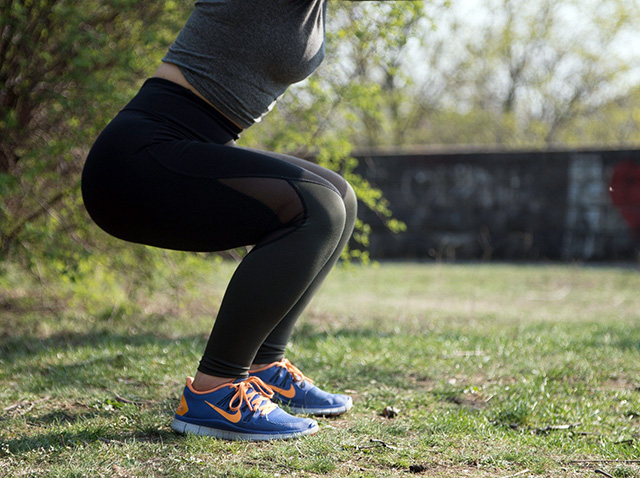The Ruffier Squat Test is a simple cardiovascular endurance test which involves measuring heart rate before and after performing 30 squats in 45 seconds. The test was originally developed in 1950s by James-Edward Ruffier and modified by J. Dickson, who developed the Ruffier-Dickson index (RDI). From the results of this squat test you can calculate the Ruffier-Dickson Index, commonly used in France to classify Cardio-respiratory fitness.
test purpose: This test assesses leg strength and endurance.
equipment required: heart rate monitor, metronome, stopwatch, recording sheets, chair, calculator, paper and pen.
pre-test: Explain the test procedures to the subject. Perform screening of health risks and obtain informed consent. Prepare forms and record basic information such as age, height, body weight, gender, test conditions. See more details of pre-test procedures.
procedure: Get the subject to sit or lie down, and after at least a few minutes, measure resting heart rate (HR1) by counting the pulse over 15 seconds. Set the metronome to a rate of 40 per minute. When ready, the subject performs 30 squats in time to the metronome (it should take 45 seconds). The squatting involves bending the knees to a 90-degree angle, while keeping the back straight and the arms extended straight forward. On completion of the 45 seconds, get the subject to immediately sit down, and the post-exercise heart rate is taken over the first 15 seconds (HR2), then again one minute after the test (HR3) from 1 minute to 1 minute 15 seconds post-exercise.
 squat test
squat testscoring: Use the heart rate measurements to calculate the Ruffier Index (RI) and the Ruffier-Dickson Index (RDI). Lower scores indicate better exercise tolerance. The RDI is designed to have less emphasis on resting heart rate measure.
RI = (HR1 + HR2 + HR3 -200) / 10
RDI = [ (HR2-70) + 2(HR3 - HR1) ] / 10
where HR1 is the average resting heart rate, HR2 is the maximum heart rate recorded during the first 15 seconds of recovery, and HR3 is the 15 second average after the 1st minute of recovery.
Here are some general ratings based on the Ruffier-Dickson Index
| RI Value | Endurance Rating |
|---|---|
| Less than 0 | Excellent |
| From 0 to 3 | Very good |
| From 3 to 6 | Reasonably good |
| From 6 to 9 | Average |
| From 9 to 12 | Moderate |
| From 12 to 15 | Poor |
| From 15 and up | Very poor |
advantages: this simple test can be self-administered, and can be done with limited equipment.
comments: The test was designed by French doctor James-Edward Ruffier. The test is widely used in France.
variations: The fitness index can also be calculated with different exercises, such as 20 push-ups performed for 30 seconds.
references:
- Dickson, J. (1950). Utilisation de l'indice cardiaque de Ruffier dans le contrôle médico-sportif, Med. Educ. Phys. Sport, 2, 65–79. [title translation: The use of the cardiac index of Ruffier in the medical control of sportsmen]
- Ruffier JE. Considerations on the index of heart resistance to effort [in French]. Med Educ Phys Sport. 1951;3:7–12.
- Joussellin E. Le test de Ruffier, improprement appelé test de Ruffier-Dickson. Medicins du sport. 2007;83(4 January 2014):33–4. [title translation: Ruffier's test, improperly called Ruffier-Dickson test]
- Guo Y, Bian J, Li Q, Leavitt T, Rosenberg EI, Buford TW, et al. (2018) A 3-minute test of cardiorespiratory fitness for use in primary care clinics.
- Sartor F, Bonato M, Papini G, Bosio A, Mohammed RA, Bonomi AG, et al. (2016) A 45-Second Self-Test for Cardiorespiratory Fitness: Heart Rate-Based Estimation in Healthy Individuals.
Similar Tests
- Chair Stand — stand up repeatedly from a chair for 30 seconds
- Home squat test — perform as many squats as you can
- Endurance Jump (30 Seconds) — jump across a hurdle as many times as possible in 30 seconds.
- Wall Squat — hold a sitting position while leaning back against a wall.
Related Pages
- List of other Strength Tests
- Measuring resting heart rate
- About Resting Heart Rate


 Current Events
Current Events